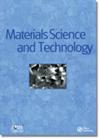MoSi2-SiC陶瓷复合材料的模切和旋转电火花加工表面和亚表面分析
IF 2.2
4区 材料科学
Q3 MATERIALS SCIENCE, MULTIDISCIPLINARY
引用次数: 3
摘要
本文章由计算机程序翻译,如有差异,请以英文原文为准。
Die-sinking and rotary EDM surface and subsurface analysis of MoSi2-SiC ceramic composites
Rotating EDM and die sinking EDM were used to compare the machinability of MoSi2-SiC composites. Surface flaws such as micro cracks, un melted spherical particles, pores, a recast layer and craters following EDM can be attributed to the high hardness and poor toughness of the MoSi2-SiC. Die sinking EDM and rotary EDM, as shown by a comparison of recast layer thicknesses, produce the most uniformly thin white layers, at 92 and 30 µm respectively. The study found that the area fraction yield for porosity ranged from 8.18% to 12.922% when using rotary EDM, but only from 2.33% to 8.10% when using die-sinking EDM. According to the EDAX, the spongy exterior of a composite is the result of a lot of gas being produced. Although the rotational movement of the tool sweeps the resolidified particles away, Rotary EDM resulted in a thinner and less uniform recast layer while still producing good surfaces.
求助全文
通过发布文献求助,成功后即可免费获取论文全文。
去求助
来源期刊

Materials Science and Technology
工程技术-材料科学:综合
CiteScore
2.70
自引率
5.60%
发文量
0
审稿时长
3 months
期刊介绍:
《Materials Science and Technology》(MST) is an international forum for the publication of refereed contributions covering fundamental and technological aspects of materials science and engineering.
 求助内容:
求助内容: 应助结果提醒方式:
应助结果提醒方式:


